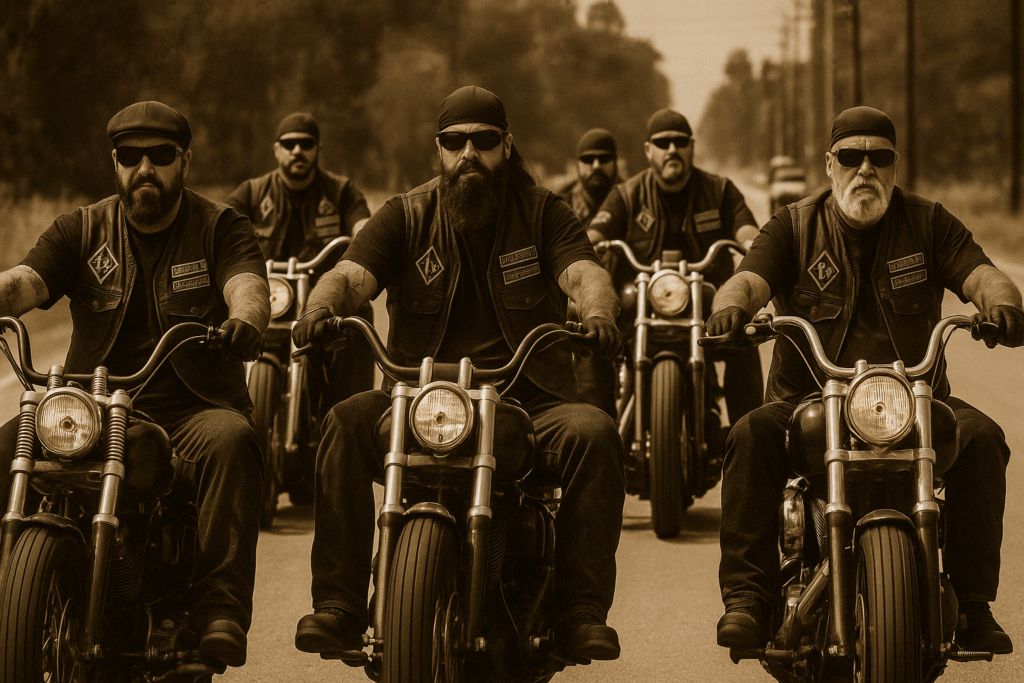
The roar of engines. The glint of chrome. The bond of brotherhood forged in oil, grit, and outlaw spirit. Few subcultures are as misunderstood — or as mythologized — as the world of 1% motorcycle clubs. Often labeled as rebels, outlaws, and even criminals, these groups have a rich and complex history that traces back to post-war America and has since evolved into a global network of fiercely loyal riders.
Let’s ride through the origins, culture, and reality behind the 1% biker scene — a world where loyalty is law, the road is sacred, and the patch means everything.
What Does “1%” Mean?
The term “1%” comes from a statement once made by the American Motorcyclist Association (AMA) in the 1940s. After a violent incident at a biker rally in Hollister, California, the AMA claimed that “99% of motorcyclists are law-abiding citizens.” In response, outlaw bikers embraced the idea that they were the “other 1%,” proud outsiders who lived by their own rules.
The “1%” patch, often a diamond-shaped emblem, soon became a symbol of defiance — proudly worn by clubs who rejected mainstream society and embraced a lifestyle of freedom, brotherhood, and in some cases, criminal enterprise.
The Birth of the Outlaw Clubs
The roots of the 1% culture trace back to World War II veterans returning home to a country that had changed. Many felt alienated and sought the camaraderie and adrenaline they once found in battle. Motorcycles became an outlet — and riding clubs were born.
Some of the earliest and most prominent outlaw clubs include:
- The Hells Angels (founded in 1948, California)
- The Outlaws MC (founded in 1935, Chicago)
- The Bandidos MC (founded in 1966, Texas)
- The Pagans MC (founded in 1959, Maryland)
- The Mongols MC (founded in 1969, California)
These clubs created their own codes, rituals, and hierarchy. Clubhouses, colors, and patches became sacred. Loyalty, respect, and retaliation were pillars of the culture.
Club Structure and Brotherhood
1% clubs are highly organized, with strict hierarchies and deep internal codes. Chapters operate semi-independently but are part of a national (and often international) structure. Key roles include:
- President – Leader of the chapter
- Vice President – Second-in-command
- Sergeant-at-Arms – Enforcer of club rules
- Secretary/Treasurer – Manages records and finances
- Road Captain – Organizes rides and logistics
- Prospects – New members on probation
Joining a 1% club isn’t easy. It often involves years of proving loyalty, earning trust, and respecting club protocol. It’s not about simply riding — it’s about living a code.
Public Perception and Reality
Hollywood and the media have often sensationalized 1% clubs, portraying them as lawless gangs involved in drugs, violence, and crime. While some clubs have faced serious legal allegations and FBI scrutiny, many members live double lives — blue-collar jobs by day, patched riders by night.
It’s essential to note that not all 1% clubs are criminal organizations, and not all members are criminals. The outlaw label refers more to living outside the norms of society, not necessarily breaking the law.
The Global Spread of 1% Culture
What began in the U.S. has spread worldwide. Today, 1% clubs have chapters in:
- Europe (especially Germany, Sweden, and the Netherlands)
- Australia and New Zealand
- South America
- Asia and Eastern Europe
This global spread has occasionally led to territorial conflicts, alliances, and turf wars, as clubs compete for dominance or expand their influence.
Brotherhood, Identity, and the Open Road
At its heart, the 1% lifestyle is about freedom, identity, and brotherhood. It’s a life lived on the edge, bound not by borders or laws, but by loyalty to the patch and the code of the road. Riders find family, structure, and meaning within their clubs — something many lacked elsewhere.
The 1% symbol isn’t just a badge — it’s a commitment to a life that most will never fully understand.
Conclusion: Beyond the Patch
The history of 1% motorcycle clubs is layered, controversial, and enduring. Whether seen as rebels, outlaws, or brothers, they remain a fascinating fixture of modern counterculture. As long as there are open roads and riders seeking freedom, the roar of the 1% will echo through time.
Hashtags
#onepercentclubs #bikerhistory #hellsangels #bandidosmc #outlawmotorcycleclubs #bikerbrotherhood #motorcycleculture #mcclubs #rebelriders #patchpride #bikerlifestyle #americanoutlaws #bikerlegacy #rideordie #freedomriders #brotherhoodforever #motorcycleoutlaws #bikerpatches #openroadlife #bikerroots #mcworld #outlawbikerhistory #undergroundculture #twoheelrebels #bikertruth #bikerrealities #motorcyclegangs #nomadriders #mcnetwork #ridewithhonor